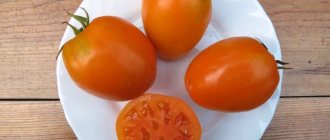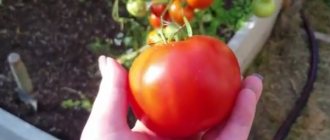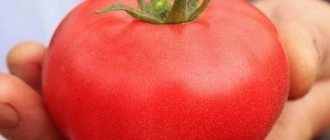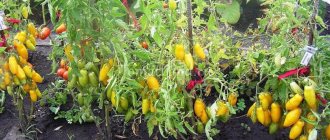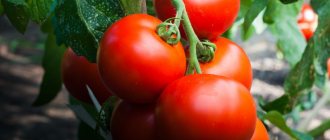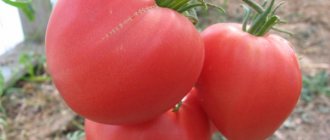Tomatoes “Bull's Heart” are a kind of “legend” of Russian gardens. Despite the fact that the variety itself was officially registered not so long ago, tomatoes with this name were cultivated by the grandparents of modern summer residents. The origin of the plants, the seedlings of which they proudly shared with their neighbors, was usually quite prosaic: the seeds were simply extracted from the most fleshy and delicious southern tomatoes bought at the market. Some owners of summer cottages still grow such “family” varieties, believing that this is the famous variety.
The fruits look very attractive: bright red, large, oval-heart-shaped
Since descriptions of the plant vary greatly and there are many misconceptions associated with the variety, we decided to talk about these tomatoes in more detail and, first, we propose to consider the main varietal characteristics:
| Parameter | Characteristic |
| Culture | Tomato (Solanum lycopersicum L. var. lycopersicum) |
| Ripening period | Late - mid-late |
| Period from germination to fruiting | 120-125 days |
| Marketable yield | 3-4 kg/m2 |
| Number of fruits per cluster | 3-4 |
| Fruit weight | 108-225 g (maximum - up to 400-500 g) |
| Form | Heart-shaped, oval, smooth |
| Fruit coloring | Bright red |
| Skin | Thin, prone to cracking |
| Pulp | Fleshy, dense, sugary, with a small amount of seeds |
| Number of slots | More than 4 |
| Taste qualities | Excellent |
| Transportability and keeping quality | Low |
| Purpose | Salad, juice making |
| Plant type | Determinate, tall (up to 150-200 cm in greenhouses) |
| Leaves | Medium size, green |
| Inflorescence | Simple; the first one is laid over the 8-9th sheet, the subsequent ones - after 1-2 sheets |
| Features of cultivation | Plants require staking and shaping, active pinching and removal of excess flower clusters |
| Disease resistance | Weak; susceptible to rot and late blight |
| Recommended growing regions | All regions (in open ground and under temporary film covers) |
| Year of registration in the Federal State Budgetary Institution "State Varietation Commission" | 2003 |
| Originator | Agro LLC (Vereya village, Moscow region) |
Packages of seeds of varieties from different manufacturers
Characteristics of the variety
Tall bushes of the determinate type grow to a height of about 1.4-1.8 m. The strong stem of the plants allows them to withstand a fruit weight of more than 500 g. Fruiting of the bushes begins 120-140 days after the appearance of the first shoots.
Most often, the variety is grown in summer cottages or private plots. The variety is not widely used on an industrial scale.
Some varieties of fruit resemble a human heart
A special feature of the Bull Heart variety is the size and shape of the fruit. They are usually pointed at the tip of the fruit and are heart-shaped. Tomatoes can weigh from 100 to 600 g.
The maximum recorded weight is about 1 kg . The largest fruits are formed on the lower part of the bushes. At the top of the stem, smaller tomatoes are 100-150 g. There can be up to 5 fruits in one cluster.
A spreading plant with a small number of leaves is suitable for growing both under cover and in open ground.
Reviews from Russian summer residents
Olga, 37 years old, Mytishchi
I plant it in a greenhouse every year. Only 2-3 bushes, just for food. The taste of the fruit is wonderful: the same one that I remember from childhood. The largest and most beautiful tomatoes (I have 350-400 g each) grow on the lower clusters. The top ones are smaller, but also tasty. But the variety is capricious. It ripens late, is afraid of late blight and suffers from blossom end rot. The stems are brittle, each one needs to be tied up separately. And the harvest is not too impressive. They say that the bushes must be actively fed, otherwise they produce little fruit.
Inga, 29 years old, Kirzhach
These tomatoes are very good in salads. I grew this variety last year in a greenhouse. I planted the seedlings in mid-May; the fruits began to turn red only in August. She led the bushes into two stems, leaving 5 brushes on each. It is interesting that the very first tomato on each plant had a very complex shape: it was not just heart-shaped, but like 3-4 “hearts” fused together.
Still, not the simplest variety. Fuss with it a lot. I sprayed it against late blight, planted it, and fed it several times. With such intensive care, the harvest turned out to be quite modest: 2.5 kilograms per bush. And almost half of the fruits had to be removed unripe. It was ripened in the room, of course, but the taste was no longer the same. I think I'll try to grow it again, but I'll sow it as early as possible (in February). I really want a lot of sweet, meaty “hearts.”
Vladimir, 42 years old, Volzhsky
Planted both in open ground and in a greenhouse. In both cases, I formed 3 stems (I left stepsons under and above the first flower cluster). In my opinion, they did better in cover. For some reason, more than half of the flowers in the garden fell off.
Our climate is quite mild, so almost all the tomatoes ripen on the bushes. The last ones were filmed at the end of September. Only those that grew from below were large and truly heart-shaped. The largest one I had weighed almost 500 g. The top brushes weighed up to 120 g, and were rather plum-shaped. The ripe fruits have a wonderful taste, but you need to eat them straight from the bush. They don’t want to lie down and it’s difficult to transport them. We used the smallest ones for juice and liked it. But these tomatoes are not suitable for marinade: the skins burst, and they don’t taste very good. There are varieties that are much better suited for this purpose. I will plant this variety again, but little by little, solely because of the taste of fresh fruits.
Natalya, 44 years old, Ryazan region.
I remember these tomatoes from childhood. My mother grew them. Every year I collected my seeds, but over time the plants began to get very sick and the fruits were crushed. Last year I bought seeds from and I was right: the tomatoes tasted very similar to my mother’s. It’s a pity that there weren’t many of them, although I trimmed the bushes and treated them for diseases. Then I only found out that the variety is very dependent on fertilizing. For next summer I will take this into account and leave fewer clusters on the stems.
Subspecies
The usual color of tomato peel is scarlet (King London, Ox heart pink).
But there are other varieties of the variety with skin:
- yellow (Brown's Yellow Giant)
- red (Bull's heart red)
- orange (Bull's heart orange F1)
- Brad's black heart
- white (White Oxheart)
The most famous varieties are those bred by Russian breeders: “Bull’s Heart Pink”, “Bull’s Heart Orange F1”, “Bull’s Heart Red”.
Brown's Yellow Giant
PROS:
- large-fruited
- high yield
- good gastronomic qualities of fruits
- presence of subspecies.
MINUSES:
- the harvested crop must be used almost immediately
- bushes require constant care
- plants have a late harvest period of about 4 months.
I have been growing "Bull's heart pink" since 1987. I'm satisfied with the yield. The bush is strong and can support up to 9 kg of tomatoes.
Simone
A friend of mine has been planting Bull's Heart tomatoes for several years. Most of all, she appreciates them for their excellent taste and size of the fruit. The first time I tried them was at her place. Now I plan to plant this variety myself on my plot.
Anna
What are bushes?
This is a determinate plant - meaning the height of the bush up to a certain point. It stops growing on its own, no need to pinch the top. The standard is considered to be a meter in height, a little more.
But more often the plants are tall and grow well in width. Suitable for growing in a greenhouse, outdoors.
In greenhouse conditions it grows up to 2 m, in the garden up to about 1.5 m. Each bush produces 3-4 shoots, and ovaries form on them.
Productivity
Plants grown under cover produce more fruit. 8-12 kg of tomatoes are harvested from one greenhouse bush. In open ground, the variety can produce 3.5-5 kg of gigantic tomatoes. Their skin is thin.
Easily separated from the pulp. The largest tomatoes form subspecies with dark skin.
Variety "Bull's heart red"
They taste sweet, with a slight sourness. The inside is fleshy, dense, not juicy. They can be eaten fresh, added to salads, or used for canning and preparing various dishes.
Varieties
Among the particularly attractive Bull's Heart hybrids are:
- Exhibition. The fruits of this variety have a dark red skin color, but are distinguished by a more rounded shape. It is recommended to grow these tomatoes in greenhouses.
- The Abakansky and King London varieties have a soft pink tint.
- Golden. Tomatoes have a more pronounced cone shape, golden skin color and sweetness.
- Peach. The salad variety of Ox's Heart is characterized by a yellowish-orange color of the fruit and a sweet fruity taste, which, when ripe, lacks acid.
- Orange. Tomatoes of this variety become bright orange during ripening and gain weight up to 0.9 kg.
- Brad's Black Heart is characterized by a dark fruit color that takes on a rich hue when exposed to intense sunlight.
- White. A variety with very light colored fruits, rarely grown in Russia. The delicate fruity taste is suitable for using tomatoes in salads.
- Brown's yellow giant is also used in cooking without cooking. The fruits have a characteristic lemon-yellow hue.
- Chocolate. When ripe, tomatoes become brick-brown in color and have a more rounded shape. The harvest is used in cooking to prepare cold dishes and sauces.
Features of agricultural technology
To obtain the maximum number of fruits in the central part of Russia, it is recommended to plant plants in a greenhouse. In most cases, they are planted in open ground only in the southern regions.
Bull's heart orange F1
It is grown by seedlings. The Bull's Heart variety is considered a demanding variety of tomatoes.
We plant the ox heart without any shelter. We follow all the rules of agricultural technology. To avoid fungal diseases, we carry out preventive measures a few weeks after planting. Tomatoes grow big and don’t get sick.
Irina
Preparing seeds for sowing
Seeds are sown in early spring . The seeds of the plant can be prepared independently in the fall, so they retain their varietal qualities. The exception is the varieties - F1 hybrids.
The following activities should be carried out:
- Place the seed material in melt water for 12 hours. You can take clean snow and put it in a warm place, or take ice out of the freezer. Melt water should be at room temperature.
- Disinfect the seeds in a solution of potassium permanganate. Seeds are poured into a slightly pink solution of potassium permanganate and kept for no more than 45 minutes. Then pour the liquid into a strainer. The remaining seeds are washed with clean water.
Brad's black heart tomato
For me, “Bull’s Heart” matures very slowly. By the end of summer, pink specimens only appear. The main part ripens after harvest. I get no more than four tomatoes in my brush.
Sidorenko
Sowing seedlings
Soil from the store is selected from the island. If the soil mixture is prepared independently, it should include:
- leaf soil
- peat
- river sand
- humus
Traditionally, wooden boxes or plastic containers are chosen as containers for planting. Fill the container with soil so that the soil does not reach 3 cm to the edges.
Sowing is carried out in pre-treated, moist, warm soil. Sowing depth – 1-2 cm. Distance between adjacent seeds – 2-3 cm.
Ripe tomato White Oxheart
After planting, the boxes are covered with transparent glass, a bag and placed in a warm place. After the first shoots appear, the shelter is removed. The box is placed in a bright place in the house.
Picking is done after the formation of 2-3 true leaves. At the same time, weak plants are removed and strong ones are transplanted into separate cups or into a more spacious box.
Hardening of seedlings
The process of hardening seedlings
Before transplanting to a permanent place, it is recommended to harden off the grown seedlings. To do this, on warm, sunny days they are taken out to the balcony, loggia or garden. The time spent in the air is increased daily.
Transplanting seedlings
Seedlings are transplanted into the greenhouse at the end of April, beginning of May. The exact timing depends on climatic conditions and the availability of heating in the greenhouse. It is recommended to plant tomatoes in open ground only in the second half of May and early June, when the danger of night frosts has passed.
Bull heart pink
If it is cold or damp outside, it is recommended to postpone transplanting seedlings to a permanent location until weather conditions improve.
Soil preparation
The soil in the area for tomatoes must contain a sufficient amount of nutrients and be air and water permeable. The pH of the soil should be between 6-6.5. You should choose a part of the garden with plenty of sunlight, but without drafts and close groundwater.
Soil preparation
It is recommended to prepare the place for seedlings in the fall by adding organic fertilizers to the ground during digging . If the soil was not enriched with organic matter at the end of the season, in the spring you should add 8-10 kg of compost or humus per m2.
It is also useful to sow green manure plants in the tomato plot in early spring:
- radish
- alfalfa
- mustard
- phacelia, etc.
If nutrients were not added either in the fall or in the spring, mineral fertilizers should be added to each hole during planting. For example, 1 tsp. nitrophoska.
The best predecessors for tomatoes: onions, root vegetables, legumes, cabbage, annual herbs.
Rules for landing in a permanent place
When growing Oxheart tomatoes in a greenhouse, be prepared for the tomatoes to take up most of the cover. This is due to the fact that they are planted in a greenhouse, leaving a distance of 1 m between the beds. The distance between two bushes is at least 40 cm.
Planting depth is 12-15 cm. Planting to a greater depth is possible, but about 4-5 cm should remain between the surface of the earth and the first true leaf. According to experienced vegetable growers, 1/3 of the stem can be buried - up to the cotyledon leaves, but not more.
Planting seedlings in open ground
If the seedlings are planted under cover, the air temperature in it should be 20-22 C during the day and 16-18 C at night. Until the seedlings take root, it is recommended to shade them during the hot sun.
We have many years of experience in growing the variety. In central Russia they do not ripen on bushes. Therefore, either they should initially be planted under cover, or already green tomatoes should be brought home and left to ripen in a warm place. But in a greenhouse they are more likely to suffer from late blight.
Lyudmila
How to grow seedlings
Seedling is a young plant that is grown from seeds. They can be bought at a specialty store or taken from grown fruits.
Before planting the seed from which the seedlings will grow, preparatory measures are carried out. The seeds are kept in water for some time and disinfected in a solution of potassium permanganate (10 g of potassium permanganate per liter of water): placed in the resulting solution, removed after half an hour.
After this, the grains are laid out on a moistened cloth, covered with a lid or film, and placed in a warm place, but not in direct sunlight. After 2-3 months, sprouts will appear from the seeds. They are planted in special soil intended for vegetable crops.
Note. Use plastic glasses or small wooden boxes as containers.
In the photo below you can see an example of growing seedlings in cups.
Before planting the sprouts in the soil, it should be heated to room temperature, divided into containers so that the layer in each of them is 3 cm, and watered with warm water. Next, using tweezers, you need to place the sprouted seeds in containers and sprinkle with a small amount of dry soil, cover with film and place in a warm place. When sprouts appear from the soil, the film can be removed.
Note : It is recommended to remove the film gradually, allowing the seedlings to get used to the ambient temperature. To do this, first remove the film for a short time, then close the containers again, and then remove the covering material completely.
After this, move the seedlings to a cooler but brighter place.
Attention ! The Bull's Heart variety is late. The right time for sowing seeds is the beginning of spring (March 1). It is better to plant seedlings from late May to mid-June.
Care
Plant care is no different from other nightshade varieties and includes:
- watering
- feeding
- loosening
- ventilation of greenhouses
- stepsoning
- mulching
- tying
Watering
The variety is considered drought-resistant. After transplanting to a permanent place, during the rooting of newly planted young plants, there is no need to water them. As soon as the bushes begin to actively grow, watering can be resumed.
On average, for 1 m2 of beds 1-2 times a week you need 5-7 liters of liquid for young plants, 12 liters for adult bushes.
Watering tomatoes over the leaves can cause fungal diseases
On hot days, during the ripening of tomatoes, the maximum amount of water is required - up to 15 l/m2.
For irrigation, you should use warm (20-22 C) settled water . The soil should be moistened early in the morning or evening. Bull's heart tomatoes should be watered only at the root, avoiding water getting on the stem and leaves.
Ventilation of the greenhouse
On warm days, greenhouses need to be ventilated daily. In hot weather, shelter windows should be kept open. Overheating the room can hinder the pollination process.
When growing tomatoes, the greenhouse must be regularly ventilated
The air humidity under the shelter should be 65-70%.
Planted in the Pushkinsky district of the Moscow region. I couldn't ripen them outdoors in open ground. My mother-in-law planted it under cover, and it was ripe before it was removed.
Tigrov
Bush formation
Bull's heart bears fruit well when the bushes form into one stem. The top of the stem is removed when 7-8 clusters with fruits form on the plant.
Stepsoning
"Bull's Heart" is heavily overgrown with stepsons. If you do not remove them in time, this leads to the fact that the bushes devote all their energy to their growth. At the same time, the fruits grow small. Therefore, this variety is not recommended for novice gardeners to plant.
Bull's heart tomatoes need staking
Pinching is the removal of excess shoots on the leaf axils. It is recommended to remove the stepsons when their length has not yet reached 5 cm. Until this moment, there is no risk of injury to the plants. The growth of such shoots must be monitored regularly. Usually the need to remove new stepsons arises every week.
Top dressing
During the growing season, tomatoes are fed 3-4 times. If signs of deficiency of any elements are noticed, the number of procedures can be increased. But nutrient mixtures are applied no more than once every 2 weeks, alternating root and foliar feeding.
Fertilizing
It is recommended to use organic matter as fertilizer. For example, chicken manure, diluted with water in a ratio of 1:15, cow manure - 1:10. Minerals can only be applied 2 months before harvest.
Recipes for preparing natural fertilizers for tomatoes
No. 1. Iodine Place 4 drops of iodine in a bucket of water. Water 2 liters for each plant. The product is not only a fertilizer, but also helps the bushes resist late blight.
No. 2. Ash Add 100 g of ash to a bucket of water. Water under each bush.
No. 3. Herbal infusion Add 5 buckets of water to 5 kg of cut grass. Add some ash and mullein. Keep for several days. Water is added to the liquid so that the final volume is 100 liters. To water 1 bush you need 2 liters of mixture.
No. 4. Yeast 11 g of dry yeast are diluted in warm water. Add 2 tbsp. Sahara. The resulting mixture is poured into a bucket of water. Each tomato is watered at the root with 500 ml of liquid.
Feeding tomatoes with natural fertilizers allows you to get an environmentally friendly product
Tying up
Plants with long stems can be tied up immediately after planting to a permanent place of growth. To do this, usually take a peg about 2 m long and bury it in the ground next to the bush.
Then the stem is tied to this peg. To prevent the top of the plant from drooping and breaking under the weight of the fruit, the location of tying is changed as it grows.
The long stems of the plant do not allow it to be grown without tying it up
You need to make sure that the tomatoes do not come into contact with the ground, as in this case they begin to darken and rot.
Mulching
The ground can be mulched with sawdust, peat, straw, etc.
To facilitate the process of caring for bushes, the ground under them can be covered with a 5 cm layer of mulch.
It performs the following functions:
- holds water in the soil
- eliminates the possibility of weed growth
- protects tomatoes in contact with the ground from rotting
Pollination
Tomatoes growing outdoors can easily be pollinated by insects and wind. There is no free air circulation in the greenhouse, so it is recommended for such plants to help in this process.
Greenhouse tomatoes sometimes need help with pollination
During flowering, some gardeners recommend simply tapping the pegs to which the plants are tied. This should be done in the morning or in the evening.
Planting seedlings and preparing for it
The Bull's Heart tomato variety is quite capricious. This also applies to the requirements for cultivation conditions. An open place is selected for the garden bed. The culture does not tolerate dense shade, but it does not like direct sunlight either. Therefore, it is advisable to grow these tomatoes under a canopy made of any white covering material.
Bull's heart tomatoes are planted so that each bush is provided with sufficient area for nutrition
Areas where groundwater is located a meter or closer below the surface of the earth are immediately excluded. If there is absolutely no alternative, you will have to build high beds (0.5 m or more).
The bushes of this variety are quite large and the root system is developed. Therefore, per 1 m² no more than two plants are placed in a greenhouse and three in open ground. The interval between neighboring bushes is about 1 m, the row spacing is 70–90 cm. You also need to provide space for a trellis or other support.
Obtaining a bountiful harvest is impossible in a substrate of poor quality. The soil must be highly nutritious, but at the same time quite light, allowing for normal aeration and not allowing moisture to stagnate at the roots. The most suitable substrate is gray soil or loam. If its composition is far from optimal, add sand (for heavy soil) or powder clay (for light soil).
The quality of the substrate is also affected by the crop previously grown in this place. Ox's heart is never planted after other tomatoes or any Solanaceae in general, if less than three years have passed. Good predecessors for the crop are green manure, herbs, onions, garlic, plants from the Pumpkin, Legume and Cruciferous families. And the Bull's Heart also benefits greatly from the proximity to garden strawberries. In both crops, the fruits ripen larger, and accordingly, the yield increases.
Eggplants, like other plants from the Solanaceae family, are undesirable precursors for tomatoes
You need to take care of preparing the beds in advance, last fall. Immediately determine the acid-base balance of the soil. If it differs from neutral, during the digging process, dolomite flour, wood ash or eggshell powder (250–450 g) are added along with the necessary fertilizers. To increase fertility, manure (necessarily rotted) or compost is distributed over the bed, approximately 10 liters per linear meter. In the fall, potassium and phosphorus fertilizers are needed - 25–30 g and 40–50 g, respectively. Nitrogen (10–15 g) is applied in the spring, simultaneously with loosening the beds, which is carried out approximately two weeks before planting the Ox Heart.
Humus is a natural remedy for increasing soil fertility
Video: preparing soil for tomatoes
The greenhouse for tomatoes is also prepared in the fall. If possible, it is advisable to completely change the soil. Or at least add 8–10 cm of fresh humus. The soil is dug up, simultaneously getting rid of all plant debris, and spilled with boiling water or a rich raspberry solution of potassium permanganate for disinfection. Glass and all surfaces in general are wiped with a solution of slaked lime for the same purpose. Or you can burn a small piece of sulfur with tightly closed doors and windows.
Ideally, before planting tomatoes in a greenhouse, you need to replace all the soil; if this is not possible, the substrate should at least be disinfected
To enrich the soil with nitrogen and improve its quality in the greenhouse at the beginning of autumn, you can plant any green manure (leaf mustard, vetch, phacelia). After about two months, the greens are mowed and embedded in the soil.
It is advisable to plant tomatoes in cloudy, not too hot weather. The soil should have warmed up sufficiently by this time. It is enough if during the previous week the daytime temperature does not fall below 17°C.
First, both the seedlings and the holes are well shed with warm water. A handful of humus and a little ash are placed at the bottom. The seedlings are planted so that at least 3–4 cm remains from the ground to the bottom pair of leaves. The bushes are well watered again, and it is advisable to mulch the bed. The next watering is carried out only when the seedlings have taken root in the new place and begin to grow. This usually takes about 10 days. Around this time they will need to be tied to a support. After another 1.5 weeks, it is advisable to hill up the bushes to stimulate the development of adventitious roots. Tomatoes in open ground are protected from direct sunlight for at least the first two weeks using covering material on the arches.
Planting tomato seedlings in the ground is practically no different from a similar procedure for other garden crops.
Video: planting tomato seedlings in a garden bed
Diseases and pests
The variety is considered not resistant to late blight . If the weather is cool and the soil is waterlogged, the disease may affect Bull's Heart.
Therefore, it is necessary to observe preventive measures:
- disinfect seeds, soil, containers, greenhouse premises before planting
- leave the required distance between bushes
- do not plant seedlings in a permanent place where other nightshades (peppers, potatoes, etc.) used to grow.
- ventilate the greenhouse
- monitor the moisture level in the soil
Some vegetable growers treat bushes twice a season with antifungal drugs for preventative purposes. Bushes with obvious signs of disease are dug up by the roots and burned.
In addition to late blight, “Bull's Heart” can become infected with fusarium, cladosporiosis, and verticillium . But unlike late blight, the variety has average resistance to these diseases.
Tomatoes are most often affected by late blight.
When growing tomatoes, I use antifungal drugs in accordance with the instructions. The plantings did not suffer from late blight. I noticed for myself that “Bull’s Heart” bears fruit better in a greenhouse than without shelter.
Faith
Advantages and disadvantages
The variety has a number of advantages:
- large fruits;
- excellent tomato taste;
- good seed germination;
- friendly return of the harvest;
- high productivity;
- versatility, variety for greenhouses and open beds;
- presence of subspecies.
In addition, the tomato variety is not a hybrid. This makes it possible to collect seeds for further sowing of seedlings and cultivation. Sometimes this feature is key; many summer residents prefer to grow seedlings themselves.
Tomatoes have few disadvantages:
- Some gardeners consider the need to create supports to be a disadvantage.
- The need for stepsoning during the growing process. However, this nuance allows you to get larger fruits and a larger harvest.
- Low resistance to some diseases can affect the safety of tomatoes, so preventive treatments are necessary.
Harvesting
Tomatoes are harvested as soon as they are ripe. Usually the first harvest can be enjoyed in July, August and until September.
It is not worth waiting for all the tomatoes on one bush to ripen, as ripe fruits quickly deteriorate.
The collection of all fruits must be completed before the night air temperature drops below 8 C. During collection, all tomatoes must be dry.
Bull's heart tomatoes do not always ripen fully on the plant
“Bull's heart” is a variety of nightshade, the fruits of which are not suitable for long-term storage. Ripe, picked tomatoes can be stored for about 2 weeks. Then the taste deteriorates, but they remain suitable for heat treatment. The transportability of the fruit is excellent.
You can choose a refrigerator or another dark, cool place in the house to store the harvested crop. The room temperature should be 5-12 C. It is recommended to place tomatoes with the stem facing up.
Growing in a greenhouse
Planting Oxheart tomatoes in a greenhouse requires a lot of space. Using a cramped greenhouse will not allow you to get a normal harvest and large fruits.
The shelter planting scheme assumes:
- the gap between the bushes is more than 0.4 m;
- row spacing is about 1.0 m;
- planting depth up to 15 cm;
- The distance from the ground to the real leaf is about 4.5 cm.
The height of the greenhouse should not be lower than 2 m, since Bull's Heart is a tall variety. The temperature inside should be maintained at 20-22°C during the day, 16-18°C at night.
Application
The size of Ox's Heart tomatoes does not make it possible to preserve them whole. They are usually used to prepare borscht dressings, lecho, salads, and ketchup. Low-juice fruits should not be used to make tomato juice.
Ox heart tomatoes can be used for canning in slices
Sweet tomatoes are great for fresh consumption. They can also be added to various hot dishes or frozen.
Analogues of tomato “ox heart”
Today, breeders have developed quite a few varieties of the variety, the most popular of which are considered to be hybrids of French and Dutch production. They are all almost the same, but it is not difficult to distinguish them from the original, and, first of all, due to the color. The original varieties included in the State Register are orange, pink and red fruits, and hybrid varieties include yellow, white and even black subspecies of “bull’s heart”. The characteristics of each subspecies are shown in the table below:
| Analogue | Peculiarities | Ripening period |
| Orange bull's heart | Weight - 300–800 g, high shelf life | Average |
| Red tomatoes (Riviera) | Oval, bright red fruits that can be collected in two passes: the first time - up to 700 g per tomato, the second - up to 350 g. | Average |
| Pink "grandmother's" | The fruits have practically no seeds and are little susceptible to diseases. Like the previous option, they can be grown in two passes: the first time fruits weighing 800 g appear, and the second - no more than 250–300 g each | Late |
| Giant blacks | Heart-shaped dark red (almost black) tomatoes. The plant reaches a height of two meters, but no more than two fruits are placed on one brush | Late |
| Crimson (giants) | The weight of the fruit is up to 800 g, there are no seeds inside, the pulp is very delicate in taste. Tomatoes are disease resistant | Late |
| Gold | Fleshy fruits, cone-shaped, weighing up to 600 g at the first harvest. Subsequently, the weight of tomatoes decreases | Average |
| Yellow (Minusinsk) | Sourish aftertaste, fruit color is whitish, with a slight yellowness. Weight - up to 400 g each tomato | Average |
If ordinary tomatoes are already “boring” and there is a desire to try something else, then exotic analogues of “bull’s heart” are just what every housewife needs. The growing characteristics and taste characteristics of such tomatoes are almost identical to the original version.
Preparing seeds for planting next season
Seeds from fruits that were grown in your own garden can be sown for no more than 4 years. In the future, they may lose varietal qualities.
Procurement of seeds
Experienced gardeners recommend preparing seeds as follows:
- select the largest tomato from the second brush from the bottom
- wait for it to fully mature
- pick the fruit and keep it in the house for several days
- cut the tomato, remove the seeds
- dry them
- put the seeds in paper envelopes
Pros and cons of the variety
“Bull’s heart” has a large number of undeniable advantages, which make it so popular among gardeners in many countries.
- The advantages of cultivating the variety are:
- high yield rates;
- good taste;
- friendly formation of ovaries;
- the possibility of growing tomatoes from self-harvested seeds;
- good transportability;
- a small amount of green mass, limiting the spread of fungal diseases.
- However, along with the listed advantages, the described tomato variety also has some disadvantages:
- low resistance to late blight and some other diseases;
- the need for frequent fertilizing with mineral fertilizers;
- mandatory formation and tying of bushes to a support;
- the possibility of fruit cracking (for some reason, thin skin is often considered the most serious drawback when growing such tomatoes).
Having compared all the advantages and disadvantages of the “ox heart” variety, we can say with confidence that it deserves attention, which is why it is increasingly found on the plots of novice and experienced vegetable growers.
Cooking recommendations
Large tomato fruits of the described variety are not suitable for whole-fruit canning, but at the same time they are an excellent ingredient in all kinds of tomato pastes, sauces and lecho. They can be used to make excellent summer soups, salads and simply stewed vegetables as an addition to the main side dish.
Did you know? In the eastern part of Spain, in the city of Buñol, a tomato battle (“Tomatina”) is held annually, during which hundreds of kilograms of tomatoes are consumed.
The main recommendations for preparing the variety include the following nuances:
- both red and yellow tomatoes are equally suitable for making tomato juice;
- In order for the tomato puree to turn out exceptionally tender and pleasant to the taste, before processing the fruit, it is advisable to remove the skin from it (it is easily separated from the pulp);
- large and overripe fruits are better suited for preservation than those that are just beginning to ripen;
- orange and golden fruits look great in a salad composition, so when creating this dish it is better to choose them;
- dark red tomatoes can be used to prepare independent tomato dishes (for example, stuffed tomatoes);
- You can pickle slightly unripe specimens that are just becoming sweet (however, not all housewives like this cooking option).
Video: Tomato variety "Bull's Heart" black
Before preparing tomato dishes, do not forget about the quality of the harvest. To create culinary masterpieces, only fresh and completely healthy fruits should be used, without the slightest signs of disease or the presence of pests.
The "bull's heart" variety is a good tomato option for planting in any area. Relatively low care requirements and high taste make these tomatoes very valuable for any gardener.

